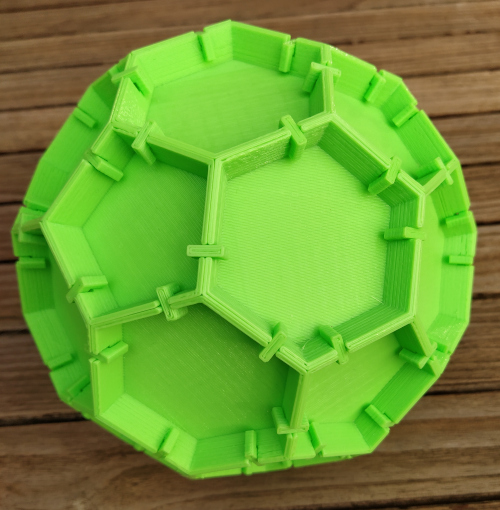Archimedean Solids Covered with Matching Polygons
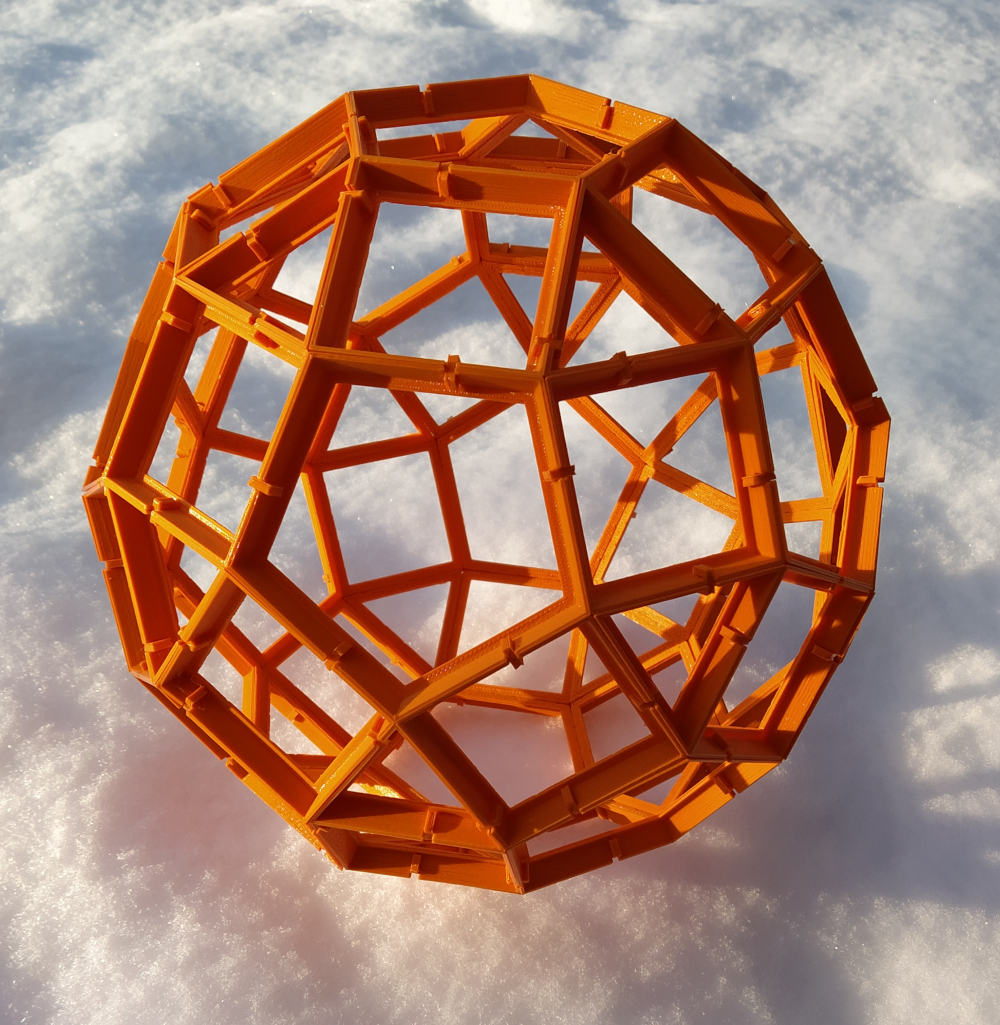
2023/01/24
Beside the Platonic solids the Archimedean solids are convex solids with regular faces and an identical structure of their vertices. I tried to
use polygons with colored sides to cover the solids so that same colored sides match at the edges of the solid. Given a fixed number of colors there are often too few or too many different polygons to cover the faces of a single Archimedean solid. Therefore some polygons must be used more than once, or some pieces with special properties must be discarded.
It's also possible to add kind of folds and gaps at these folds to connect the polygons by U-clips. The positions for the gaps are: center (0), right from center (1), left from center (-1), far right from center (2) and far left from center (-2). A gap x then matches a gap -x. At the virtual objects the center positions are always red marked, left and right positions are blue marked and the more distant positions are green marked. In this case the folds must lie in a plane defined by two corners of the polygon and the center of the solid. Above you can see a printed version of such a rhombicosidodecahedron.
For the Archimedean solids with more than 30 faces you should use a suitable order to place the polygons onto the solid. For instance you can sort the faces due to the height of their centers of gravity.
For the printed versions I also took solid polygons.
Click the pictures in the table to see examples of covered Archimedean solids and the used sets of polygons. If you click these examples you can also see virtual models of them.
Cuboctahedron
|
Polygons |
Used Colors or
Positions of Marks |
Restrictions on the Polygons |
Possible Pieces |
Sets |
All Pieces |
|
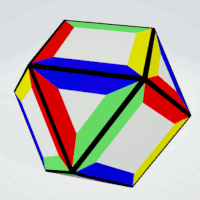 |
Squares | 4 | all sides must be different | 6 | 1 | 6 |
 |
| Triangles | 4 | all sided must be different | 8 | 1 | 8 |
 |
Squares | 3 | three equal sides,
one different side | 6 | 1 | 6 |
 |
| Triangles | 3 | all sides must not be equal | 8 | 1 | 8 |
 |
Squares | 3 | two pairs of equal sides | 6 | 1 | 6 |
 |
| Triangles | 3 | all sides must not be equal | 8 | 1 | 8 |
That's a real construction with colors. You can start with the net for the solid and put the magnetic polygons on an iron surface.
Truncated Cube
|
Polygons |
Used Colors or
Positions of Marks |
Restrictions on the Polygons |
Possible Pieces |
Sets |
All Pieces |
|
 |
Octgons | 2 | exactly two equal sides
not neighboring | 6 | 1 | 6 |
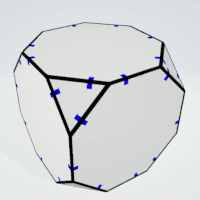 |
| Triangles | 2 | - | 4 | 2 | 8 |
 |
Octagons | 2 | exactly two equal sides
not opposite | 6 | 1 | 6 |
 |
| Triangles | 2 | - | 4 | 2 | 8 |
In the printed version all triangles have a gap at the center of their sides. The octagons have also center gaps at four sides but between these sides the other ones have gaps right or left from center. It's easy to arrange the octagons with matching gaps, and then you can finish the construction.
Truncated Icosahedron
|
Polygons |
Used Colors or
Positions of Marks |
Restrictions on the Polygons |
Possible Pieces |
Sets |
All Pieces |
|
 |
Hexagons | 2 | at least two sides of each kind | 10 | 2 | 20 |
 |
| Pentagons | 2 | all sides must not be equal | 6 | 2 | 12 |
 |
Hexagons | 2 | exactly three equal sides
aren't allowed | 10 | 2 | 20 |
 |
| Pentagons | 2 | all sides must not be equal | 6 | 2 | 12 |
This is a real solid where the marks are replaced by gaps, and the polygons are connected at these points.
Icosidodecahedron
|
Polygons |
Used Colors or
Positions of Marks |
Restrictions on the Polygons |
Possible Pieces |
Sets |
All Pieces |
|
 |
Pentagons | 4 | exactly four equal sides | 12 | 1 | 12 |
 |
| Triangles | 4 | all sides must not be equal | 20 | 1 | 20 |
 |
Pentagons | 2 | all sides must not be equal | 6 | 2 | 12 |
 |
| Triangles | 2 | - | 4 | 5 | 20 |
|---|
Here is the net and the finished construction of the solid.
Rhombicuboctahedron
|
Polygons |
Used Colors or
Positions of Marks |
Restrictions on the Polygons |
Possible Pieces |
Sets |
All Pieces |
|
|
 |
Squares | 4 | all sides are different | 6 | 3 | 18 |
 |
| Triangles | 4 | all sides are different | 8 | 1 | 8 |
 |
Squares | 3 | two pairs of equal sides | 6 | 3 |
|  |
| Triangles | 3 | all sides must not be equal | 8 | 1 | 8 |
|---|
Snub Cube
|
Polygons |
Used Colors or
Positions of Marks |
Restrictions on the Polygons |
Possible Pieces |
Sets |
All Pieces |
|
|
 |
Squares | 4 | all sides are different | 6 | 1 | 6 |
 |
| Triangles | 4 | all sides are different | 8 | 4 | 32 |
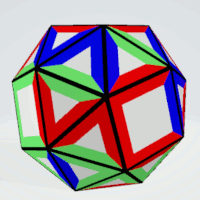 |
Squares | 3 | exactly three sides are equal | 6 | 1 | 6 |
 |
| Triangles | 3 | all sides must not be equal | 8 | 4 | 32 |
|---|
Snub Dodecahedron
|
Polygons |
Used Colors or
Positions of Marks |
Restrictions on the Polygons |
Possible Pieces |
Sets |
All Pieces |
|
|
 |
Pentagons | 2 | all sides must not be equal | 6 | 2 | 12 |
 |
| Triangles | 3 | all sides must not be equal | 8 | 10 | 80 |
|
 |
Pentagons | 2 | all sides must not be equal | 6 | 2 | 12 |
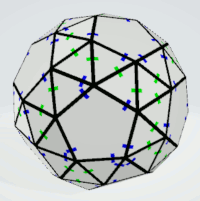 |
| Triangles | 4 | all sides must not be equal | 20 | 4 | 80 |
 |
Pentagons | 2 | all sides must not be equal | 6 | 2 | 12 |
 |
| Triangles | 4 | all sides must be different | 8 | 10 | 80 |
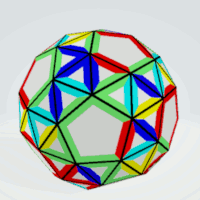 |
Pentagons | 2 | all sides must not be equal | 6 | 2 | 12 |
 |
| Triangles | 5 | all sides must not be equal | 40 | 2 | 80 |
If five colors are available for the triangles but only two for the pentagons it's necessary to keep track of the triangles with all colors different from the two colors for the pentagons. With these triangles only a restricted number of places can be covered.
Truncated Icosidodecahedron
|
Polygons |
Used Colors or
Positions of Marks |
Restrictions on the Polygons |
Possible Pieces |
Sets |
All Pieces |
|
|
 |
Decagons | 2 | eight or nine equal sides | 12 | 1 | 12 |
 |
| Hexagons | 2 | at least two sides of each kind | 10 | 2 | 20 |
| Squares | 2 | - | 6 | 5 | 30 |
Rhombicosidecahedron
|
Polygons |
Used Colors or
Positions of Marks |
Restrictions on the Polygons |
Possible Pieces |
Sets |
All Pieces |
|
|
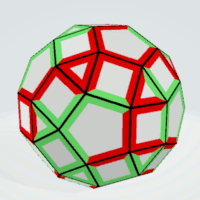 |
Pentagons | 2 | all sides must not be equal | 6 | 2 | 12 |
 |
| Squares | 2 | - | 6 | 5 | 30 |
| Triangles | 2 | - | 4 | 5 | 20 |
 |
Pentagons | 4 | exactly four equal sides | 12 | 1 | 12 |
 |
| Squares | 4 | all sides are different | 6 | 5 | 30 |
| Triangles | 4 | all sides must not be equal | 20 | 1 | 20 |
 |
Pentagons | 4 | exactly four equal sides | 12 | 1 | 12 |
 |
| Squares | 4 | Two or four kinds of sides | 30 | 1 | 30 |
| Triangles | 4 | all sides must not be equal | 20 | 1 | 20 |
One construction is shown at the top of the page. Due to the computer solution I placed the pieces like a net for the solid. After this two parts of the "sphere" were constructed so that they could be combined to get the
whole solid.
The obj-files for the 62 polygons are here.
Truncated Cuboctahedron
|
Polygons |
Used Colors or
Positions of Marks |
Restrictions on the Polygons |
Possible Pieces |
Sets |
All Pieces |
|
|
 |
Octagons | 2 | exactly two equal sides
not opposite | 6 | 1 | 6 |
 |
| Hexagons | 2 | four or five equal sides | 8 | 1 | 8 |
| Squares | 2 | - | 6 | 2 | 12 |
 |
Octagons | 2 | exactly two equal sides
not neighboring | 6 | 1 | 6 |
 |
| Hexagons | 2 | four or five equal sides | 8 | 1 | 8 |
| Squares | 2 | - | 6 | 2 | 12 |
Truncated Tetrahedron
|
Polygons |
Used Colors or
Positions of Marks |
Restrictions on the Polygons |
Possible Pieces |
Sets |
All Pieces |
|
|
 |
Hexagons | 2 | two pairs of three equal sides | 4 | 1 | 4 |
 |
| Triangles | 2 | exactly two equal sides | 2 | 2 | 4 |
 |
Hexagons | 2 | exactly five equal sides | 2 | 2 | 4 |
 |
| Triangles | 2 | exactly two equal sides | 2 | 2 | 4 |
no solution |
Hexagons | 2 | at least five equal sides | 4 | 1 | 4 |
 |
| Triangles | 2 | exactly two equal sides | 2 | 2 | 4 |
Truncated Octahedron
|
Polygons |
Used Colors or
Positions of Marks |
Restrictions on the Polygons |
Possible Pieces |
Sets |
All Pieces |
|
|
 |
Hexagons | 2 | two pairs of three equal sides | 4 | 2 | 8 |
 |
| Squares | 2 | - | 6 | 1 | 6 |
 |
Hexagons | 2 | four or five equal sides | 8 | 1 | 8 |
 |
| Squares | 2 | - | 6 | 1 | 6 |
Truncated Dodecahedron
|
Polygons |
Used Colors or
Positions of Marks |
Restrictions on the Polygons |
Possible Pieces |
Sets |
All Pieces |
|
|
 |
Decagons | 2 | eight or nine equal sides | 12 | 1 | 12 |
 |
| Triangles | 2 | - | 4 | 5 | 20 |
Home





